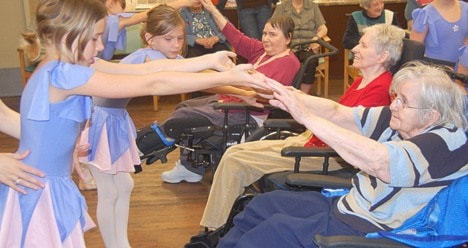The Pleasant View residents’ eyes light up as the little girls approach, stretching their frail arms forward to grasp the ballerinas hands. They are about to dance.
Some of the residents are confined to wheelchairs, while others can stand with a little help from the smiling girls in their violet and pink leotards, but as they begin to wiggle and move a smile creeps across their faces.
The girls are Grade 2 and 3 students from E.S. Richards Elementary taking part in an intergenerational dance class project with Pleasant View seniors, instructed by Lee Kwidzinski.
“For them to see children, it just changes their whole demeanor. They become very excited, and engage with the children,” she said, adding kids help the seniors reach beyond physical limitations and dementia common in care homes.
Before the class begins the girls go in a group saying good morning to each resident, usually receiving a “Good morning, dear” and a wide smile in return. Even those who can’t seem to smile light up as the girls approach.
The program began as a pilot project four years ago and has included West Heights and Christine Morrison elementary in the past, but from the very beginning it was never designed for residents to just sit and watch, said Kwidzinski.
“Those residents are engaged right from the minute the kids walk into the room. The reason we do it is that magic between generations which I think has really been lost in our society, and it’s such a natural bond,” she said.
The interactions and relationships between the children and elders are being recorded through a documentary film produced by the University of the Fraser Valley. Shelley Canning, a nursing instructor at UFV, wants to publish the results of the study in a scientific journal with kinesiology colleague Michael Gates.
Canning became involved when she saw Kwidzinski put on a performance involving residents and children at the Clarke Theatre three years ago. She became determined to let the world know how special the program is and how it improves quality of life for people in residential care, a difficult prospect for health care workers.
Children haven’t learned about stereotyping based on age, so they approach elders with more openness than other age groups might, she said.
“I even asked them in the beginning, ‘how old is old?’ I think one of them said 30. One of them said 100. So, there’s nothing concrete in their little minds,” said Canning.
Although some children were hesitant at first for fear they might hurt the seniors, Canning said they have learned that patience and kindness is rewarding virtue.
Kwidzinski says that’s why the program isn’t just for the elders, but also teaches children empathy.
“They’re not always just what we see, some small frail body slouched in a wheelchair. There’s more to them,” she said, adding you can see a longing from the elders to play again.
Some elders can stand up and do many dance moves while others enjoy just swaying to the music. And when somebody exceeds their own expectations there’s laughter, an infectious joy that spreads from young to old alike.
“So in essence they are miles apart but they’re so similar. Their wants and needs are so simple,” said Kwidzinski.
